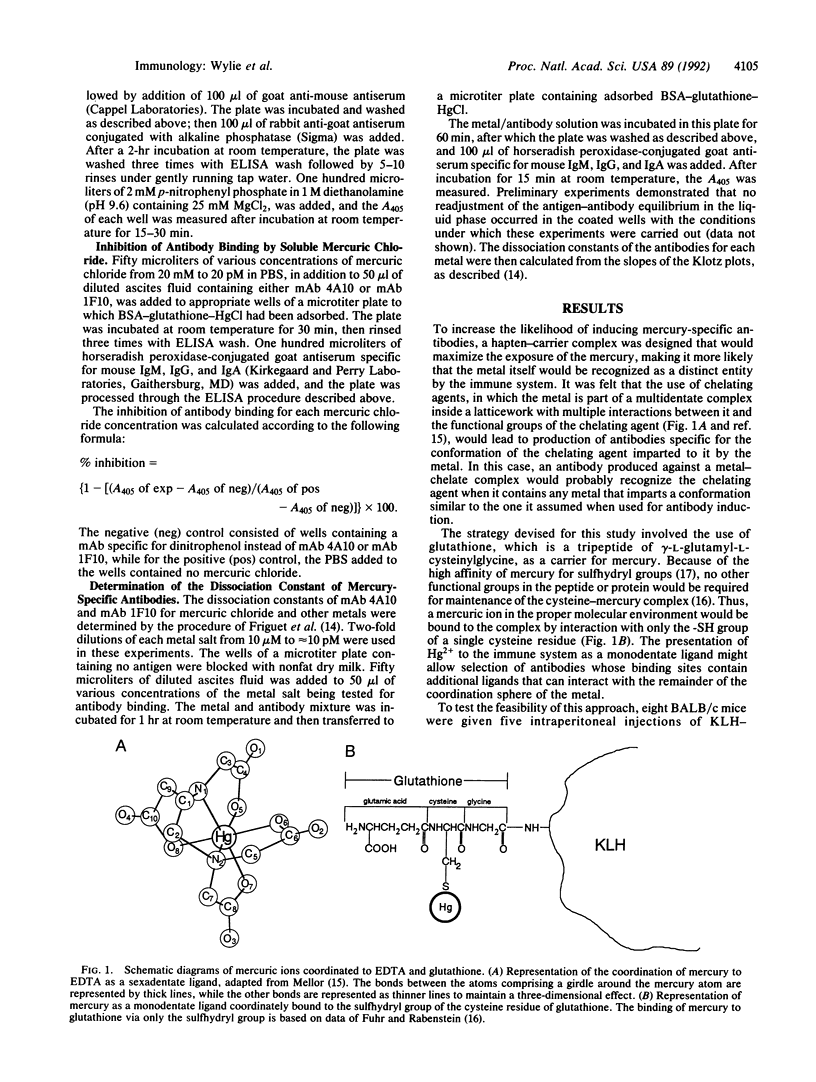Abstract
Monoclonal antibodies (mAbs) that react with soluble mercuric ions have been produced by injection of BALB/c mice with a hapten-carrier complex designed to maximize exposure of the metal to the immune system. Three hybridomas producing antibodies that reacted with bovine serum albumin (BSA)-glutathione-HgCl, but not with BSA-glutathione, were isolated from the spleen of a mouse given multiple injections with glutathione-HgCl conjugated to keyhole limpet hemocyanin. Stable subclones were established from two of these antibodies, designated mAb 4A10 and mAb 1F10. The binding of both antibodies to immobilized BSA-glutathione-HgCl was inhibited by soluble HgCl2, and dissociation constants for mercuric chloride binding were 2.3 and 3.7 nM for mAbs 4A10 and 1F10, respectively. Both antibodies bound mercuric acetate with similar affinities, demonstrating that the antibodies were capable of binding to mercuric ions in the presence of a different counterion than the one used in the immunogen. Reactions were not observed with other metal cations by either antibody. These data demonstrate the successful induction of antibodies that react very specifically with mercuric ions in solution regardless of the presence of a carrier.
Full text
PDF




Selected References
These references are in PubMed. This may not be the complete list of references from this article.
- Alzari P. M., Lascombe M. B., Poljak R. J. Three-dimensional structure of antibodies. Annu Rev Immunol. 1988;6:555–580. doi: 10.1146/annurev.iy.06.040188.003011. [DOI] [PubMed] [Google Scholar]
- Baker B. L., Hultquist D. E. A copper-binding immunoglobulin from a myeloma patient. Studies of the copper-binding site. J Biol Chem. 1978 Dec 10;253(23):8444–8451. [PubMed] [Google Scholar]
- Church W. R., Messier T., Howard P. R., Amiral J., Meyer D., Mann K. G. A conserved epitope on several human vitamin K-dependent proteins. Location of the antigenic site and influence of metal ions on antibody binding. J Biol Chem. 1988 May 5;263(13):6259–6267. [PubMed] [Google Scholar]
- Dardenne M., Savino W., Berrih S., Bach J. F. A zinc-dependent epitope on the molecule of thymulin, a thymic hormone. Proc Natl Acad Sci U S A. 1985 Oct;82(20):7035–7038. doi: 10.1073/pnas.82.20.7035. [DOI] [PMC free article] [PubMed] [Google Scholar]
- Davies D. R., Padlan E. A., Sheriff S. Antibody-antigen complexes. Annu Rev Biochem. 1990;59:439–473. doi: 10.1146/annurev.bi.59.070190.002255. [DOI] [PubMed] [Google Scholar]
- Friguet B., Chaffotte A. F., Djavadi-Ohaniance L., Goldberg M. E. Measurements of the true affinity constant in solution of antigen-antibody complexes by enzyme-linked immunosorbent assay. J Immunol Methods. 1985 Mar 18;77(2):305–319. doi: 10.1016/0022-1759(85)90044-4. [DOI] [PubMed] [Google Scholar]
- Fuhr B. J., Rabenstein D. L. Nuclear magnetic resonance studies of the solution chemistry of metal complexes. IX. The binding of cadmium, zinc, lead, and mercury by glutathione. J Am Chem Soc. 1973 Oct 17;95(21):6944–6950. doi: 10.1021/ja00802a013. [DOI] [PubMed] [Google Scholar]
- Iverson B. L., Lerner R. A. Sequence-specific peptide cleavage catalyzed by an antibody. Science. 1989 Mar 3;243(4895):1184–1188. doi: 10.1126/science.2922606. [DOI] [PubMed] [Google Scholar]
- Lewis R. M., Furie B. C., Furie B. Conformation-specific monoclonal antibodies directed against the calcium-stabilized structure of human prothrombin. Biochemistry. 1983 Feb 15;22(4):948–954. doi: 10.1021/bi00273a037. [DOI] [PubMed] [Google Scholar]
- Lindgärde F., Zettervall O. Characterization of a calcium-binding IgG myeloma protein. Scand J Immunol. 1974;3(3):277–285. doi: 10.1111/j.1365-3083.1974.tb01258.x. [DOI] [PubMed] [Google Scholar]
- Matsui H., Pallen C. J., Adachi A. M., Wang J. H., Lam P. H. Demonstration of different metal ion-induced calcineurin conformations using a monoclonal antibody. J Biol Chem. 1985 Apr 10;260(7):4174–4179. [PubMed] [Google Scholar]
- Pfeiffer N. E., Mehlhaff P. M., Wylie D. E., Schuster S. M. Monoclonal antibodies specific for bovine pancreatic asparagine synthetase. Production and use in structural studies. J Biol Chem. 1986 Feb 5;261(4):1914–1919. [PubMed] [Google Scholar]
- Reardan D. T., Meares C. F., Goodwin D. A., McTigue M., David G. S., Stone M. R., Leung J. P., Bartholomew R. M., Frincke J. M. Antibodies against metal chelates. Nature. 1985 Jul 18;316(6025):265–268. doi: 10.1038/316265a0. [DOI] [PubMed] [Google Scholar]
- Roberts V. A., Iverson B. L., Iverson S. A., Benkovic S. J., Lerner R. A., Getzoff E. D., Tainer J. A. Antibody remodeling: a general solution to the design of a metal-coordination site in an antibody binding pocket. Proc Natl Acad Sci U S A. 1990 Sep;87(17):6654–6658. doi: 10.1073/pnas.87.17.6654. [DOI] [PMC free article] [PubMed] [Google Scholar]
- Stearns D. J., Kurosawa S., Sims P. J., Esmon N. L., Esmon C. T. The interaction of a Ca2+-dependent monoclonal antibody with the protein C activation peptide region. Evidence for obligatory Ca2+ binding to both antigen and antibody. J Biol Chem. 1988 Jan 15;263(2):826–832. [PubMed] [Google Scholar]
- Wylie D. E., Carlson L. D., Carlson R., Wagner F. W., Schuster S. M. Detection of mercuric ions in water by ELISA with a mercury-specific antibody. Anal Biochem. 1991 May 1;194(2):381–387. doi: 10.1016/0003-2697(91)90245-o. [DOI] [PubMed] [Google Scholar]


